Brendan Muldowney’s Pilgrimage as a comment on religion, medieval or modern
[Spoilers. Post assumes you have seen the film or are aware of the detailed summary, as well as the list of errors in the portrayal of religious history in the film. And I assume you have thought at least a little about “how relics work.” Edited for syntax.]
***
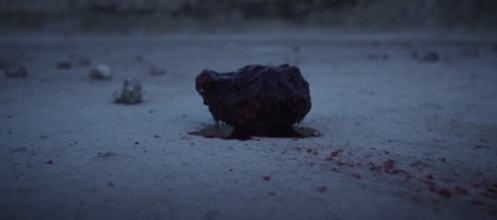
The rock used to kill St Matthias; the bodies of his tormentors have been swallowed up by the ground.
Informed observations about religion are hard to elucidate from Pilgrimage because the script doesn’t make a lot of sense on this level. It’s not a film about medieval religion, for sure. The film treats the “relic” of St Matthias as if it were a microwave that at some point bricks itself. The characters from Ciaran to Diarmuid to Geraldus to Raymond de Merville all of speak of it and think about it this way — anachronistically. Because (if operated correctly) microwaves work whether I believe they do or not; this is a fundamental characteristic of science / technology, that they “work” according to process, without respect to person or belief of the person using them. In contrast, relic piety is a form of symbolic belief; its literal aspect (what the relic is seen to accomplish visibly for those venerate it or against those who threaten it) is the least important piece of the belief. If medieval people “believed” in microwaves in the way they did in relics, cooking the food would have been much less important than how you changed after the food was cooked. In other words, more important is what the symbolic belief accomplishes internally, in the life and after-life of the believer. The purpose of relic veneration was not to inspire faith (as the script for the film pounds upon, repeatedly and wrongly), but piety, as the medieval church prioritized the cooperation of humans in their salvation. Relics were supposed to move their observers to act piously, not give rise to belief itself. Thus their failure to work literally in that — in contrast to microwaves — they did not always accomplish supernatural tasks on command did not jeopardize the project of religious belief generally. In the Latin West, belief in G-d was of a quality on par with our own contemporary belief in the theory of gravity. It’s also a shame that the film equates relic skepticism, which was widespread among Crusaders, and anti-clericalism (hostility to the Church, or to priests), which was even more broadly common in many population segments, with a lack of belief in G-d or religion themselves. The decision to describe Pilgrimage as “medieval action adventure” is thus more accurate than any association the film could make with medieval religion as it was.
I read the film as fundamentally anti-religious, not just anti-Catholic, although the latter would not be surprising in the work of an Irish filmmaker. Because the film is set in thirteenth-century Europe, the religion it criticizes happens to be [its distorted vision of] Latin Catholicism. I take this view from a number of moments:
- the monks’ apparent confusion over the burning cover on the reliquary — that Cathal’s hand is burned because he touched the reliquary, whereas we as observers “know” that the reliquary cover included metal that got warm;
- the Irish monks’ confusion of the malevolence of the Tuatha Dé Danann with that of microbes from a rotting sheep carcass and Ciaran’s dosing of the Mute while Frere Geraldus claims to be free of stomach pain; again we “know” that if Geraldus and the Mute have different experiences, this is the psychological effect of Geraldus’ imprecatory prayers on himself;
- the way that no bodies appear in Geraldus’ retelling of the martyrdom of St Matthias, and Geraldus’ insistence that Matthias was “elevated” into Heaven — the story seems like a spurious excuse to cover the fact that Matthias’ attackers were not indeed swallowed by the ground;
- the periodic reappearance of sounds that are not the “clang” of the Angel fighting the Norse attackers in the monastery’s story of the relic, but are productively confused with this sound as evidence of the relic’s efficacy (especially by Geraldus);
- the suggestion that the after-effects of the Mute’s violent association with the service of the Church, perhaps in the Holy Land, have left him with some kind of PTSD which is he is trying to run away from along with the consequences of his sins;
- the obliviousness of the most conventionally religious character, the Baron de Merville, to his son’s plans; the status of the most violent character, Raymond de Merville, as the representative of rationalism and pragmatism; and the status of the most prominent representative of the Church as institution, Frere Geraldus, as crazed, religious fanatic and status-obsessed;
- Frere Geraldus’ repeated, opportunist offers of “salvation” (actually indulgences) to anyone who will undertake the relic’s violent defense, especially the Mute;
- The relic’s failure to “defend itself” when pillaged by the Ua Mordha; and Geraldus’ grasping-at-straws defense of the relic narrative with the clang of the swords being that of the Angel;
- the fact that the representative of what we today would call “true religion” and the character most free of any ulterior motive, cautious, pacifist Brother Ciaran, dies the most painful, violent death of any character, all the while ineffectually forgiving his murderer (I hate this cheap kind of plotting, I have to admit — watching this again today made me mildly angry);
- Geraldus’ association of the Devil with the obviously most naive, innocent character in the film, Diarmuid
- the gradual picking-off of all of the brothers and the decision of the Mute to die (for what? love of Diarmuid or protection of the mission?)
- the ending of the film, in which Diarmuid is left alone with the relic and doesn’t know where to go (implication: religion gets your friends killed and then leaves you isolated and directionless).
As I have tried to communicate, several of the ‘problems’ the film presents around the relic and belief in the relic would not have been problems for medieval people. Because we are ‘modern’ and most of us do not believe in relic pieties in the way the film wants us to think the monks do anyway, as viewers we are not troubled by these things. But Brendan Muldowney said that the script allowed the film to explore “more modern themes of how religion is used in today’s political landscape.” I was also told by someone who talked to Muldowney after the premiere that he said that “Raymond de Merville is the most modern character.”
So I’ll take Muldowney at his word and start from the possibility that this film offers a comment on modern uses of religion. One thing he seems to be trying to criticize is violence committed in the name of religion. This point is nothing new and it is not presented in a novel or striking way here; what is odd about the film, though, is how randomly and inexplicably violent his characters are in the service of that goal. It’s also nothing unique to religion insofar as people will be violent in the name of anything to which they feel their identity to be tied, including family interest (as is Raymond de Merville) or even (cough) fandom. So the more serious question is why they are willing to be violent in a more narrow sense, and the fairly clear answer seems to be: to defend a relic whose actual functioning the film indicates that they all misunderstand out of naivete (the Irish monks) or fanaticism (Geraldus) or blatant self-interest (Raymond de Merville). Raymond de Merville is an interesting cusp case in that he seems to understand the significance of symbolic belief, even though he, too, is chasing after the actual relic; but his attitude toward the relic and the possibility of salvation is ultimately cynical. The only characters with something like sincere belief combined with a real understanding of the world are either oblivious to what’s going on (the Baron de Merville) or powerless and eventually dead (Brother Ciaran).
I don’t like this kind of narrative, which makes the observer so superior to the events she’s watching, but what I took this character distribution to “mean” is that Muldowney et al seem to be saying that a mechanistic belief in relics, which are a sort of placeholder for any supernatural belief that can’t be proven and is easily misunderstand, is a destructive calumny perpetrated on the innocent at the hands of the fanatical (Geraldus) or the self-interested (Geraldus and Raymond de Merville). In the end, those who belief most sincerely or naively are destroyed or quite literally marooned, while the realists die in the bloodbath they’ve orchestrated. I don’t think this reading is either extrapolated or significantly more unsubtle than the film itself. The characters who are likable are so because they are innocent (Diarmuid), loyal (the Mute), or resigned (Ciaran) — never because they are pious or sincere (with the possible exception of Ciaran, although I don’t know if we can characterize him as sincere or “authentic” — in any case, he’s orthodox for all the good it does him).
This is, indeed, ultimately a contemporary judgment on religion (whether on its medieval or its modern variant or both). It’s also a very simplistic one. To assume that because medieval pieties were heavily ritualistic (the Eucharist, relic veneration, etc.) they were also empty — remember that Raymond de Merville is considered a modern character because he has this insight — is condescending. Even today, some people take away a great deal from ritualistic pieties (and I can say from personal experience: don’t knock it till you try it, by which I mean, make a real investment of time and effort and see what happens). The demand for “authenticity” or “sincerity” in belief is an eighteenth-century requirement that doesn’t fit well with religions (like medieval Christianity, or traditional Judaism, or certain varieties of Islam) that place a great deal of emphasis on particular repetitive practices as opposed to beliefs.
But to equate medieval pieties with modern variants in order to draw the same lessons from them is just plain uninformed, particularly for someone who claims to be “obsessed with religion.” If we take the question of the monks’ belief in supernatural causation around the relic (as with the burning of Cathal’s hand) or around the stream that flows through the fairy fort (when the Mute becomes ill after drinking), the implication seems to be that people who believe in a simple way, or believe in received traditions, or believe what an institution teaches them, are deceived or incapable of understanding cause and effect. If they’d just stop and think a bit, they’d understand what is really causing the burn or the stomachache. If only they had science, they’d really understand the world, but since they don’t, they are condemned only to react. This view miscomprehends how medieval people saw causality as related to relics; if a relic didn’t do what it was expected to do, that wasn’t the fault of the relic itself. But it’s perhaps marginally credible as a way of describing people who formulated their views in the absence of what we today call “science,” which is the result of hypothesis, experimentation and argument. As a view of modern religion, however, it’s simply inaccurate; people who embrace quasi-supernatural views in the wake of Enlightenment are not naive; they do it not because knowledge is unavailable to them, but as a reaction against knowledge. Faith is not “fixed” by science; indeed, I know a lot of conventionally religious scientists. Medieval supernatural belief is a function of a worldview; modern supernatural belief is largely a reaction against a particular worldview. To put it another way — when Giotto painted as he did, it was new; but anyone who paints in the style of Giotto today, be it ever so faithful and similar, is saying something different. Composing in the style of Beethoven after you’ve heard Schonberg is less an action than a reaction.
We might describe the film’s pounding insistence on faith as the basis for its characters’ loyalties in similar terms. Faith is repeatedly described as a decision for a particular kind of sentiment (by the pope, to call a crusade; by Geraldus, as a prescription for how the Irish monks should view the Normans, and so on). This is truly a modern view that has very little nothing to do with the middle ages; when we say that the medieval period was the “age of faith” we mean that it was suffused with religion and that religion was an important political motivator, not that people wandered the earth making religious commitments on the basis of sentiment. Religious sentiment was the result of piety, not (as the Enlightenment, with its emphasis on authenticity, wanted it to be) the other way around. As I’ve noted, relic skepticism in the middle ages was not the same thing as religious doubt, which was practically non-existent in the Latin West before the mid-seventeenth century.
I couldn’t figure out if there was something going on in this film about fundamentalism / literalist belief; some scenes seemed to go that way, but the medieval world did not embrace what we today call scriptural literalism; it had a highly complex hermeneutic that interpreted texts on the basis of at least three different metaphorical devices. But even today, literalism has highly symbolic qualities, and this is why resort to facts (about the age of the earth’s crust, or the development of organisms based on the fossil record, and so on) has no effect at all in dissuading people from fundamentalist Christian beliefs. The point of creationist geology or a dinosaur museum is making a response to a scientific discourse that demands “facts”; it’s the expression of, not a reason for, embracing a literalist faith. That it’s not true on a scientific level is entirely beside the point.
As a religious person, one becomes used to the possibility that religion will be used instrumentally, not just by filmmakers, but even by the people who practice it, to tell stories about only superficially related things. The colors, the spectacle, the violence, the supernatural, the sheer exotic quality of religion — and especially of pre-modern religion — all lend themselves well to such narratives. What’s frustrating about Pilgrimage, though, is that no one undertook the effort to understand either medieval religion or modern religion beyond the most superficial platitudes used to describe them. Silence — a film to which this one has been compared repeatedly — is not by any means a perfect film and were it not an adaptation of a novel, one might legitimately take it to task for not being more critical of Jesuit mission as such. But what Scorsese et al did that Muldowney et al did not (and perhaps this is because Scorsese is said to be devout) is to take time to understand the period’s piety and to show in a non-condescending, non-ironic way how both Jesuit brothers and their Japanese converts experienced it and consider thoughtfully why it motivated them.
In comparison, Pilgrimage is not so much scornful as simply clueless — and that about its main theme — so that it remains the uninformed comment of the obsessed outsider to religion. It is completely uninformed about the motivation of the religious, while the villains air their motivations at every opportunity. This wouldn’t be so distressing if religious currents and sentiments were not so central to the problems we’re having in the public realm these days, and if it weren’t necessary at least to try to understand how religion works for people with strong beliefs and practices. Pilgrimage obscures, rather than aids, that task.

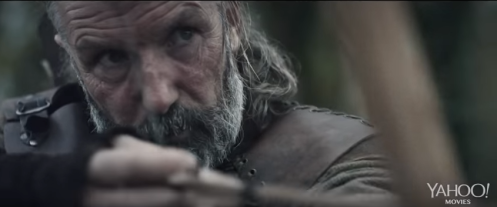
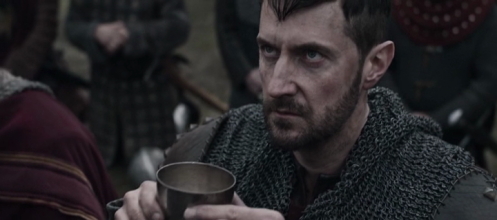


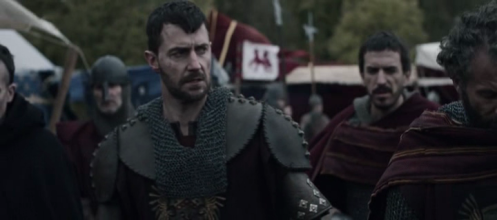
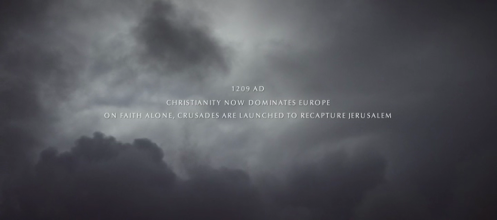


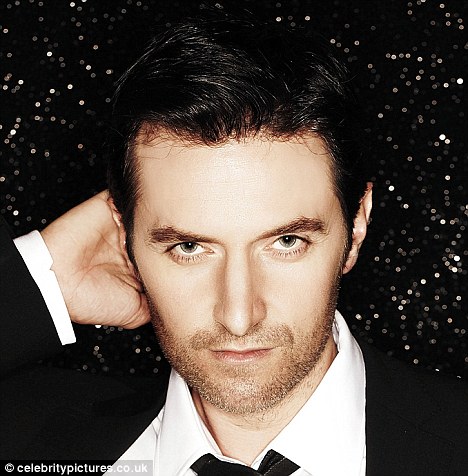


Fascinating! I love it when you give me the breakdown.
LikeLike
thank you!
LikeLiked by 1 person
Thank you ! Grâce à vos explications le film sera encore plus intéressant à découvrir, quand il sera disponible.
Connaissez-vous l’origine géographique, géologique de la pierre noire (volcan, météorite, pierre précieuse,…?
LikeLike
If I had to guess, I’d say igneous.
LikeLike
I think I need to watch the film a second time before formulating an opinion. There is stuff in it that doesn’t quite sit right with me. The language is def one as well as parts within the plot (it simplifies too much, is uninformed as you said) and characters. The landscape is gorgeous though.
Overall, they did well considering the budget constraints, but the script would have benefited from deeper research.
LikeLike
I’m always torn about this stuff. On the one hand, it’s just cheap entertainment, why devote this much effort to it? (answer: because it’s me and I am like this). It does bother me when I can see in so many places that just a little reading would have helped a lot. On the other hand, if it’s art, isn’t it worth criticism? But I do sometimes think that I am putting more weight on stuff than it will bear. Yet it’s frustrating when the thing that is easiest to fix (the script) is the real problem, as opposed to the things that cost money like costumes or effects or whatever.
And yes — Ireland is lovely. Looking forward to hearing more from you.
LikeLike
[…] Now, excuse me, I have to get back to my history classroom. Where we do real research and ask what twelfth-century authors meant when they wrote about fantastical animals instead of condescending to people who didn’t have the amazing scientific knowledge of the twenty-first century. Something that the film, Pilgrimage, does as well. […]
LikeLike
The other thing that’s particularly galling | Me + Richard Armitage said this on August 5, 2017 at 12:33 am |
[…] interviews that the directors were atheists or wanted to say something about religion). Admittedly I’ve had this issue before when resentful atheists write film scripts about the Church. Here it once again was hard on the plot. The film more or less passes over Laura’s suicide […]
LikeLike
As promised, more thoughts about The Lodge [includes all the spoilers] #richardarmitage | Me + Richard Armitage said this on June 28, 2019 at 4:07 am |